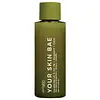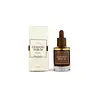What's inside
What's inside
 Key Ingredients
Key Ingredients

 Benefits
Benefits

 Concerns
Concerns

No concerns
 Ingredients Side-by-side
Ingredients Side-by-side

Water
Skin ConditioningPropylene Glycol
HumectantGlycerin
HumectantCentella Asiatica Extract
CleansingPhenoxyethanol
PreservativeButylene Glycol
HumectantHydroxypropyl Bisstearamide Mea
Skin ConditioningPolyglutamic Acid
Skin ConditioningChlorphenesin
AntimicrobialBehenyl Alcohol
EmollientDipropylene Glycol
HumectantTetrasodium EDTA
Ascorbic Acid
AntioxidantCeteareth-20
CleansingCholesteryl Isostearate
EmollientTricaprylin
MaskingCetearyl Alcohol
Emollient1,2-Hexanediol
Skin ConditioningCholesterol
EmollientSqualane
EmollientArtemisia Princeps Leaf Extract
Skin ConditioningStearic Acid
CleansingDimethicone
EmollientSodium Hydroxide
BufferingWater, Propylene Glycol, Glycerin, Centella Asiatica Extract, Phenoxyethanol, Butylene Glycol, Hydroxypropyl Bisstearamide Mea, Polyglutamic Acid, Chlorphenesin, Behenyl Alcohol, Dipropylene Glycol, Tetrasodium EDTA, Ascorbic Acid, Ceteareth-20, Cholesteryl Isostearate, Tricaprylin, Cetearyl Alcohol, 1,2-Hexanediol, Cholesterol, Squalane, Artemisia Princeps Leaf Extract, Stearic Acid, Dimethicone, Sodium Hydroxide
Water
Skin ConditioningPanax Ginseng Root Extract
EmollientButylene Glycol
HumectantBetaine
Humectant1,2-Hexanediol
Skin ConditioningCamellia Sinensis Leaf Extract
AntimicrobialGlycerin
HumectantPanax Ginseng Seed Oil
EmollientGlycyrrhiza Uralensis Root Extract
Skin ConditioningPaeonia Albiflora Root Extract
Skin ConditioningAngelica Gigas Root Extract
Skin ConditioningRheum Palmatum Root Extract
AstringentAngelica Pubescens Root Extract
Skin ConditioningSchizonepeta Tenuifolia Extract
Skin ConditioningPhellodendron Amurense Bark Extract
Skin ConditioningHydroxyethylcellulose
Emulsion StabilisingCyclopentasiloxane
EmollientDimethiconol
EmollientBis-PEG-18 Methyl Ether Dimethyl Silane
EmollientEthoxydiglycol
HumectantAcrylates/C10-30 Alkyl Acrylate Crosspolymer
Emulsion StabilisingTromethamine
BufferingPEG-60 Hydrogenated Castor Oil
EmulsifyingEthylhexylglycerin
Skin ConditioningHydrolyzed Glycosaminoglycans
HumectantHyaluronic Acid
HumectantGlyceryl Polyacrylate
Adenosine
Skin ConditioningDisodium EDTA
Water, Panax Ginseng Root Extract, Butylene Glycol, Betaine, 1,2-Hexanediol, Camellia Sinensis Leaf Extract, Glycerin, Panax Ginseng Seed Oil, Glycyrrhiza Uralensis Root Extract, Paeonia Albiflora Root Extract, Angelica Gigas Root Extract, Rheum Palmatum Root Extract, Angelica Pubescens Root Extract, Schizonepeta Tenuifolia Extract, Phellodendron Amurense Bark Extract, Hydroxyethylcellulose, Cyclopentasiloxane, Dimethiconol, Bis-PEG-18 Methyl Ether Dimethyl Silane, Ethoxydiglycol, Acrylates/C10-30 Alkyl Acrylate Crosspolymer, Tromethamine, PEG-60 Hydrogenated Castor Oil, Ethylhexylglycerin, Hydrolyzed Glycosaminoglycans, Hyaluronic Acid, Glyceryl Polyacrylate, Adenosine, Disodium EDTA
 Reviews
Reviews

Ingredients Explained
These ingredients are found in both products.
Ingredients higher up in an ingredient list are typically present in a larger amount.
1,2-Hexanediol is a synthetic liquid and another multi-functional powerhouse.
It is a:
- Humectant, drawing moisture into the skin
- Emollient, helping to soften skin
- Solvent, dispersing and stabilizing formulas
- Preservative booster, enhancing the antimicrobial activity of other preservatives
Butylene Glycol (or BG) is used within cosmetic products for a few different reasons:
Overall, Butylene Glycol is a safe and well-rounded ingredient that works well with other ingredients.
Though this ingredient works well with most skin types, some people with sensitive skin may experience a reaction such as allergic rashes, closed comedones, or itchiness.
Learn more about Butylene GlycolGlycerin is already naturally found in your skin. It helps moisturize and protect your skin.
A study from 2016 found glycerin to be more effective as a humectant than AHAs and hyaluronic acid.
As a humectant, it helps the skin stay hydrated by pulling moisture to your skin. The low molecular weight of glycerin allows it to pull moisture into the deeper layers of your skin.
Hydrated skin improves your skin barrier; Your skin barrier helps protect against irritants and bacteria.
Glycerin has also been found to have antimicrobial and antiviral properties. Due to these properties, glycerin is often used in wound and burn treatments.
In cosmetics, glycerin is usually derived from plants such as soybean or palm. However, it can also be sourced from animals, such as tallow or animal fat.
This ingredient is organic, colorless, odorless, and non-toxic.
Glycerin is the name for this ingredient in American English. British English uses Glycerol/Glycerine.
Learn more about GlycerinWater. It's the most common cosmetic ingredient of all. You'll usually see it at the top of ingredient lists, meaning that it makes up the largest part of the product.
So why is it so popular? Water most often acts as a solvent - this means that it helps dissolve other ingredients into the formulation.
You'll also recognize water as that liquid we all need to stay alive. If you see this, drink a glass of water. Stay hydrated!
Learn more about Water